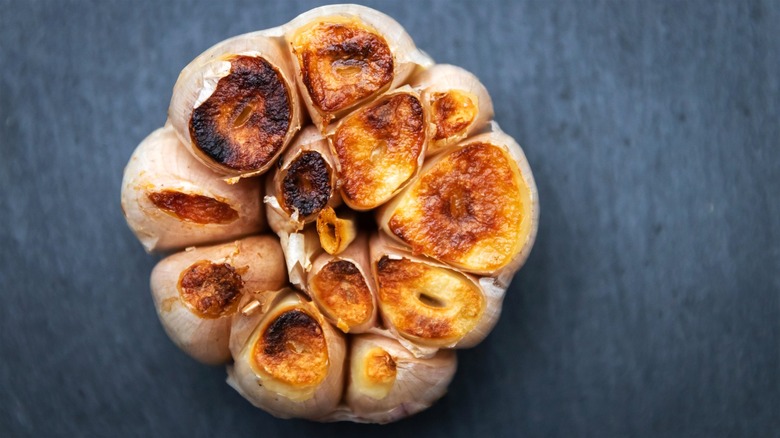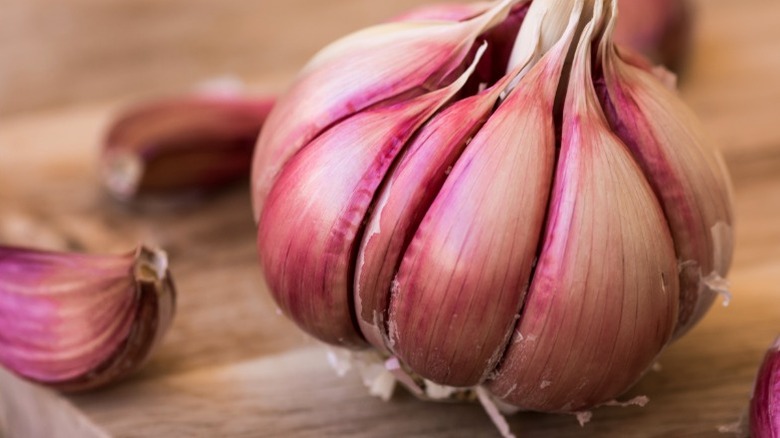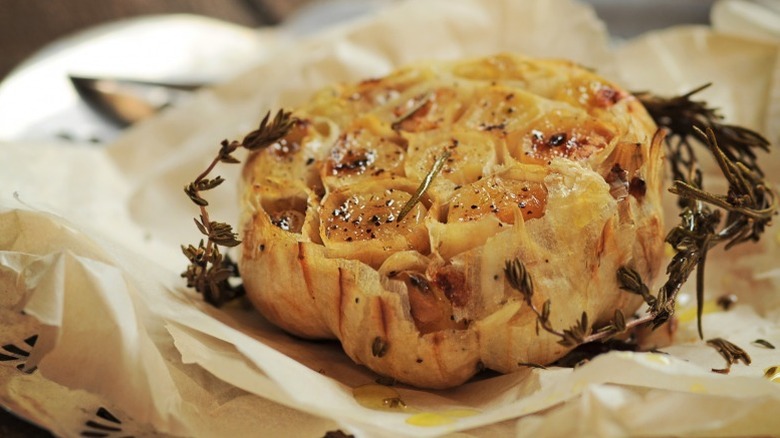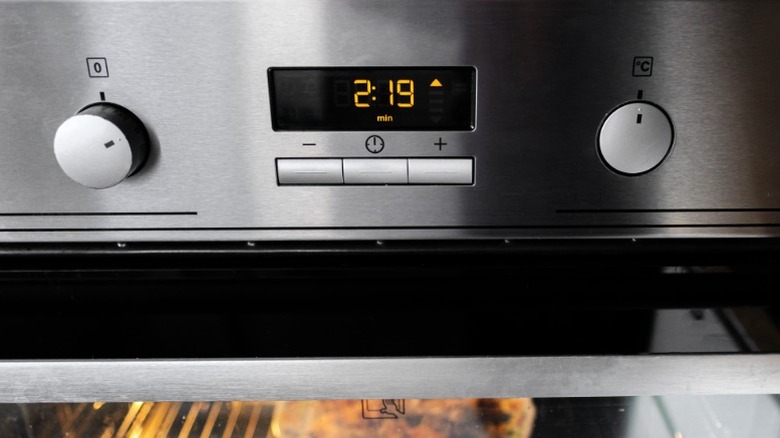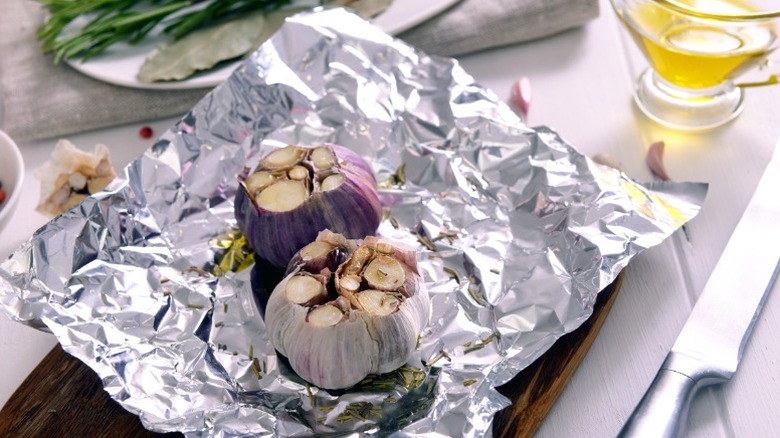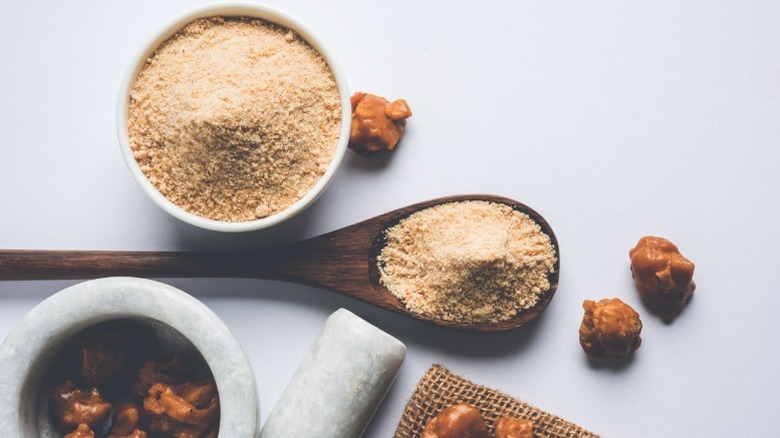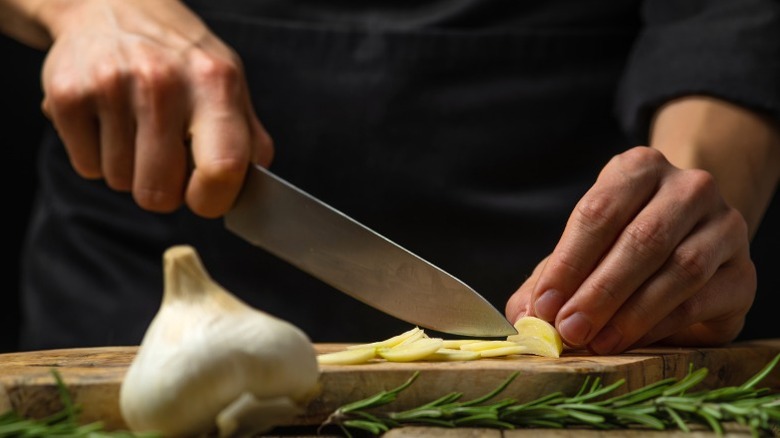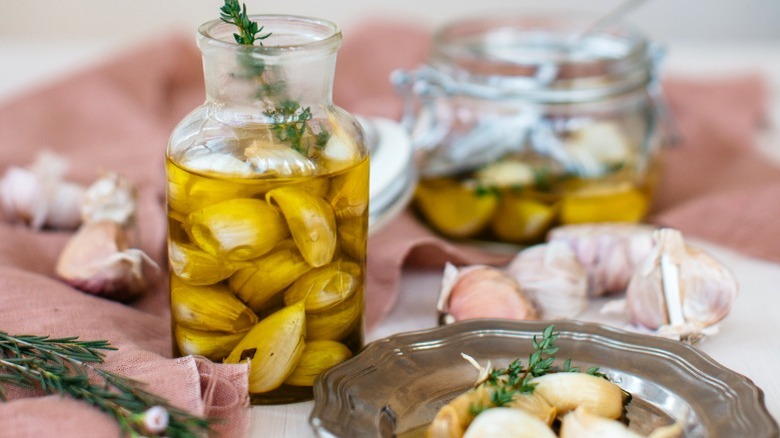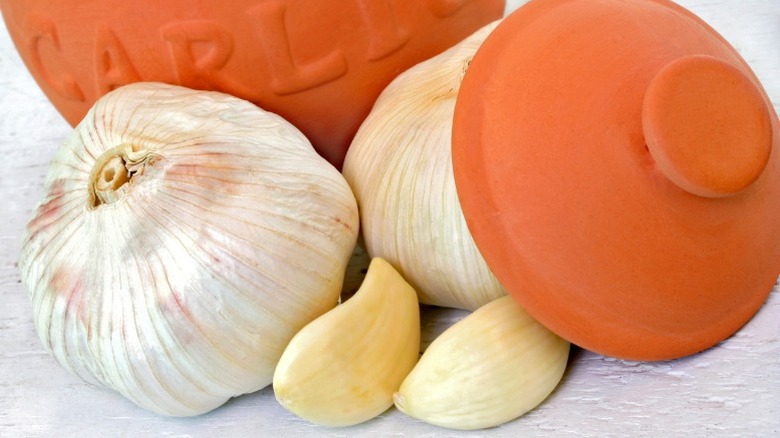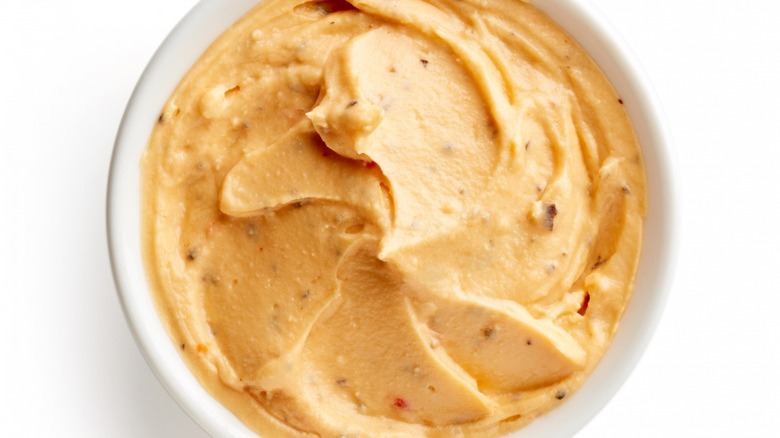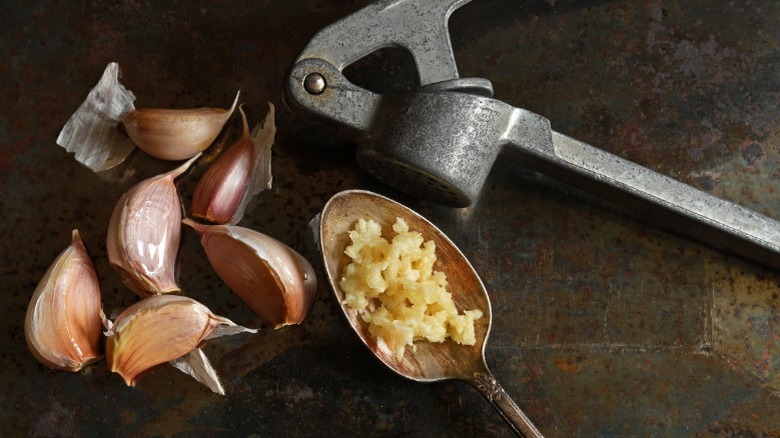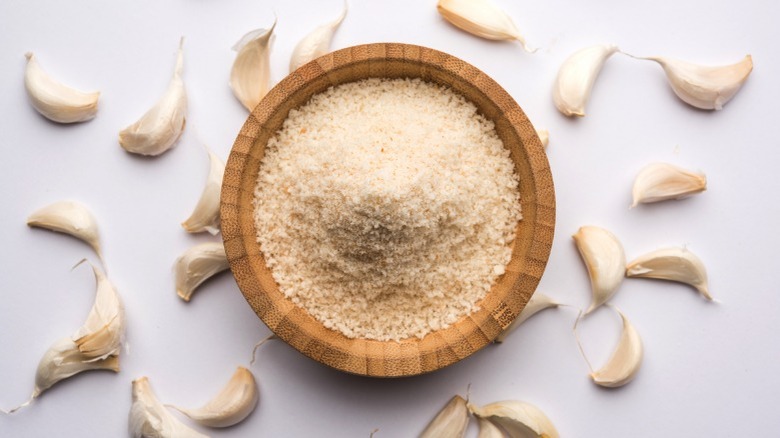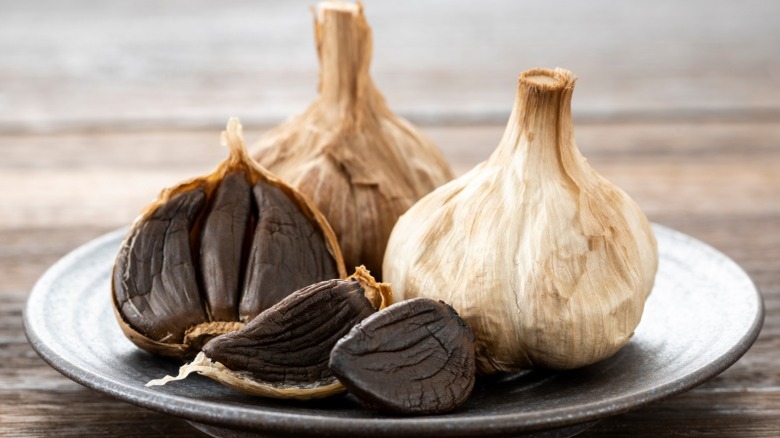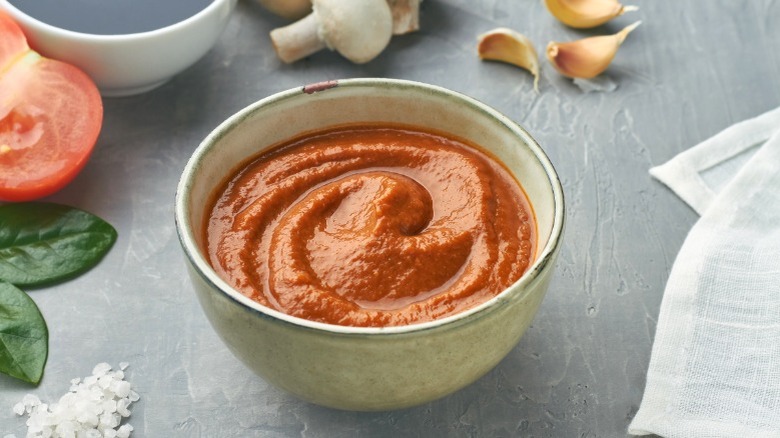13 Tips You Need To Amplify The Flavors Of Roasted Garlic
Poor man's treacle, nectar of the gods, stinking rose — no matter what they call garlic, one thing is certain: no one is indifferent to its flavor and aroma. But if you're not a fan of fresh or barely-cooked garlic's pungency and sharp taste, we're here to help you explore its soft and sweet side. Introducing roasted garlic, an ingredient as deep and versatile as simple it is to make. Its rich, caramelized flavor can add depth and complexity to a variety of dishes, from soups and sauces to spreads and marinades. But while roasting garlic may seem simple enough, there are many ways to amp up its flavor and make it the star of your dish.
In this article, we'll explore different ways to enhance and maximize different qualities of roasted garlic, taking it from a supporting player to a flavor powerhouse. We'll compare cooking techniques, from roasting whole bulbs to making garlic confit, and explain how to make your own roasted garlic powder. We'll also cover the many ways you can pair roasted garlic with other flavor-packed ingredients to create nuanced combinations. So, whether you're a long-time garlic lover looking to take your dishes to the next level or a novice cook in pursuit of new flavors, read on to discover efficient ways to amplify roasted garlic flavor.
Pick the right type of garlic
If you have ever wondered why your roasted garlic turns out less-than-perfect, you might want to look into different variations of garlic to find which one best suits your purpose. The standard purple stripe is an excellent choice for those trying to achieve a rich, sweet flavor via the traditional roasting method (packing the whole bulb in foil). Its cloves are on the smaller side, but the flavor they pack makes up for it. On the other end of the spectrum, there's solo garlic, which comes in a single-clove form. If you prefer to slow-roast peeled garlic in oil and would like to skip the arduous peeling process, this could be the variety for you. Ultimately, the best-suited garlic variety will depend on the roasting technique you're using and the flavor you're looking to achieve, so don't be afraid to experiment with different options.
Try different roasting techniques
Here's some good news: whatever your equipment is, you can likely roast your garlic in it. Here at Tasting Table, we tried almost every way to roast garlic to see which method yields the best results and found that ultimately, it depends on your priorities. Looking to save energy in the kitchen? Use an air fryer instead of an oven, and expect crispier results.
Not a fan of cooking in foil? Place your bulbs into a muffin tin (although you might have to reserve it for garlic roasting purposes only from this point forward). Working with pre-peeled cloves? Roast them in oil on the stovetop or in the oven, and get a two-for-one deal: caramelized cloves and garlic-infused oil. Finally, if your roasted garlic craving can be put on hold for five hours, we recommend trying the slow cooker method, which results in the softest, most spreadable cloves.
Watch the time and the temperature
As is often the case in the kitchen, time and temperature play a critical role in achieving perfection. The biggest mistake people make when roasting garlic is not cooking it long enough and using high heat. We get it — you want to enjoy that creamy, flavorful goodness as soon as possible. But there's no need to rush things. To make sure it cooks evenly and develops that deeply caramelized flavor, you need to roast it at 375 degrees Fahrenheit for about 45 minutes.
Overcooking garlic, on the other hand, can result in burnt and bitter cloves. It's also important to note that the size of the garlic heads and the oven's calibration can affect the cooking time and temperature. Therefore, keeping a close eye on the garlic as it roasts and adjusting the oven settings as needed is essential. You'll get the hang of it eventually.
Be generous with oil, and don't forget seasoning
Garlic might be a flavor-packed ingredient in its own right, but there are some basic add-ons that can highlight, contrast and amplify it during roasting. It's the humble trio of fat, salt, and freshly cracked pepper that even celebrity chefs like Emeril Lagasse swear by. You want your head of garlic to caramelize all the way through, and a tablespoon or two of olive oil or another type of fat will help you get there.
Make sure the oil gets into all the crevices after you have sliced off the tops before you roast it. Salt and pepper are also a must since they will offset the natural sweetness of roasted cloves, but you can take it a step further by adding red pepper flakes or some aromatic woody herbs. These seasonings are optional, but experimentation might uncover new depths of flavor.
Add a tiny pinch of asafoetida
Whether you're a fan of Indian cuisine, an ayurvedic cooking aficionado, or simply a seasoned plant-based eater, you are likely familiar with asafoetida. Also referred to as hing (and sometimes even as "devil's dung"), this spice is revered for its medicinal properties and ability to aid the digestion of legumes and reduce flatulence, per WebMD. It is also notorious for its strong, pungent aroma that might be offputting at first. However, cooking it down mellows the smell and produces a familiar allium-like flavor, which makes it asafoetida one of the best substitutes for garlic powder. To amplify the flavor of garlic with asafoetida, either add it to the seasoning mix before roasting or temper it in oil for 5-10 seconds, then pour both over the prepped garlic. The amount of asafoetida needed will depend on your personal preference and the amount of roasted garlic being used.
Cut it before roasting
The more you manipulate garlic prior to cooking, the more of its flavor and aroma comes forward. That's because breaking down its cells releases alliin and alliinase, which react with each other and create allicin, a compound responsible for the signature garlic flavor. Thus, roasting roughly chopped or thickly sliced garlic will produce a more robust flavor, making it a great addition to marinades, dressings, and sauces.
Alternatively, if you let it crisp up, it will become a great crunchy topping. To roast such garlic, spread it evenly on a baking sheet, and drizzle with olive oil. Roast in the oven for 10-15 minutes, stirring occasionally, until golden brown. However, it's important to note that minced garlic can burn quickly if not monitored closely. Therefore, it's essential to keep an eye on the garlic while it's roasting and stir it frequently to prevent it from burning.
Roast individual cloves in oil
Garlic is one of the foods that work best for the confit process for a good reason. Roasting garlic cloves in an oil bath not only cuts down cooking time but also adds richness and depth of flavor. Plus, it's a fuss-free method for those preferring pre-peeled garlic. To make it, submerge whole cloves in neutral oil and cook at 250 to 325 degrees Fahrenheit for 45 minutes to two hours until they are tender and fragrant.
The resulting garlic confit is soft and buttery, making it perfect for spreading on toast, and adding to pasta or other dishes to enhance their flavor. As a bonus, you get garlic-flavored oil to infuse other dishes with. But all this goodness comes with a serious botulism warning: not refrigerating your confit in an airtight container as soon as it cools down (ideally within a couple of hours) equals making a potentially fatal mistake.
Use a garlic baker
If you're looking for a hands-off approach to roasting garlic that is foil-free (and doesn't stink up your muffin tins), consider investing in a garlic baker. Also known as garlic roasters, these dome-shaped pots are designed to bring out the best in roasted garlic, and they have several advantages over traditional cooking methods. For one, the terracotta material of the pot allows for slow, steady heat to penetrate the garlic bulbs, resulting in tender, evenly roasted cloves.
Another advantage of using a garlic baker is that it helps to contain the strong garlic aroma during roasting. The pot lid traps the garlic aroma inside, which can help prevent the smell from permeating your kitchen or home. Additionally, this feature prevents the bulbs from drying out, resulting in tender cloves. To achieve this effect, soak the pot in water for 15 minutes before placing it in the oven.
Puree it with butter
Pairing roasted garlic with fat and spices is a great way to amplify its flavor. A remarkable quality of fat is its ability to absorb and enhance the taste of other components and merge them to form a consistent flavor. Adding spices and herbs to the butter can further improve its aroma and mouthfeel, creating a complex and nuanced taste — the chipotle and roasted garlic compound butter recipe is one scrumptious example of this. The chipotle adds a smoky, spicy flavor that balances the sweetness of the roasted garlic, while the parsley and cilantro add a fresh, herbaceous note.
The process of making compound butter is simple. Soften the butter, and then mix in the roasted garlic and other spices in a food processor until well combined. Then either shape it into a log to firm up or serve it in individual ramekins straight away.
Mix it with more garlic
Garlic in all of its forms — fresh, fried, roasted, powdered — is often used as a flavor enhancer in savory dishes. Each preparation method brings out different aspects of the garlic flavor, so mixing roasted garlic with one or more other garlic varieties will take it to the next level.
According to Reddit, you can kick your dish up a notch by contrasting roasted cloves' mellow sweetness with freshly minced garlic's pungency. A true garlic lover might even be so bold as to blend these two with some crispy fried garlic or garlic powder in a single pasta dish or a vegetable ragout. When using multiple types of garlic at once, remember to balance the flavors so that one doesn't overpower the others. Start by using small amounts of each and adjust to taste. With some trial and error, you'll find the right combination.
Dehydrate it to make roasted garlic powder
Dehydrating and grinding up caramelized cloves is a great way to satisfy your roasted garlic flavor cravings anytime you want and add a burst of sweet umami flavor to your recipes.
You can go about it one of several ways. First, you can roast whole garlic bulbs as normal, then squeeze out the softened cloves and turn them into a paste. Smear it across a silicone sheet and place it in the oven at a low temperature until it dries out (or better yet, use a dehydrator if you have one). Blend or grind until you achieve a fine powder. Alternatively, you can roast garlic slices on a lined baking sheet at 375 degrees Fahrenheit until brown and brittle (about 25 minutes). The flavor might be more garlicky in this case, thanks to the allicin buildup that occurs when the cloves are cut.
Ferment it to maximize flavor
If you're a true fan of caramelized garlic flavor and want to take it to the next level, consider trying black garlic. This unique ingredient has a deep, complex flavor that's been compared to molasses, balsamic vinegar, and even chocolate. And if they don't sell it where you live, don't fret: making your own black garlic is a relatively simple process that involves slow-cooking whole heads of garlic at low heat over several weeks.
All you'll need is a few bulbs, a designated slow cooker or yogurt maker you don't mind imparting a permanent garlic scent on, and time. Let it cook at a low temperature for several weeks until the cloves turn black and develop a sweet, tangy flavor. When cooking with black garlic, remember that a little goes a long way. Its intense flavor can easily overpower other ingredients, so use it sparingly.
Pair it with other flavor-packed foods
A universal piece of cooking advice over the last decade is to amp up the flavor in your savory dishes by mixing umami-packed foods. Roasted garlic, with its caramelized and slightly sweet flavor, is ideally suited to complement ingredients rich in that delectable fifth flavor, such as mushrooms, miso paste, and tomatoes. For example, roasted garlic can be added to a mushroom risotto or a stir-fry with soy sauce and bok choy for a delicious and savory dish. It can also be paired with fermented nut cheeses on a vegan charcuterie board or blended into a sauce.
Other ingredients that pair well with roasted garlic include roasted vegetables like carrots, sweet potatoes, and cauliflower. And if you spread your buttery roasted garlic on bread, top it with the best tomato confit, herbs, and freshly cracked salt and pepper, you'll end up with an out-of-this-world delicious snack.
